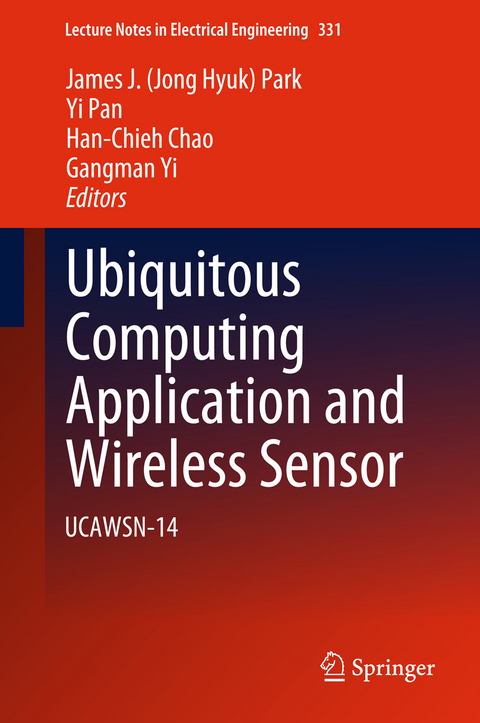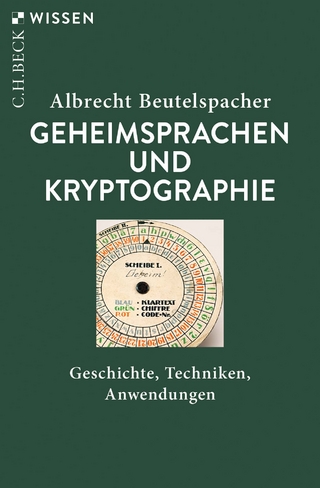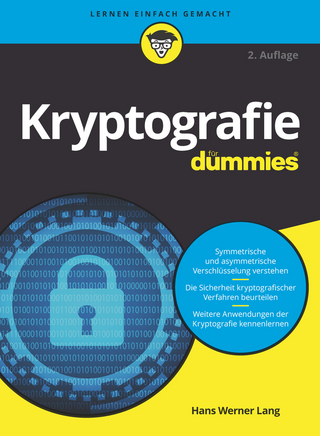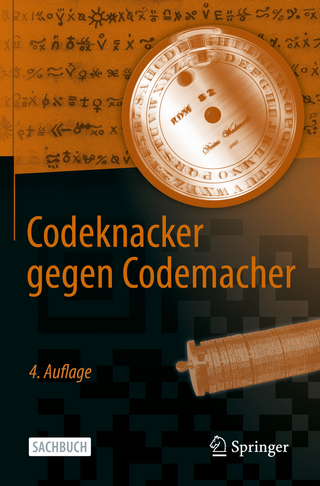
Ubiquitous Computing Application and Wireless Sensor
Springer (Verlag)
978-94-017-9617-0 (ISBN)
IT changes everyday’s life, especially in education and medicine. The goal of ITME 2014 is to further explore the theoretical and practical issues of Ubiquitous Computing Application and Wireless Sensor Network. It also aims to foster new ideas and collaboration between researchers and practitioners. The organizing committee is soliciting unpublished papers for the main conference and its special tracks.
Professor James J. (Jong Hyuk) Park received his Ph.D. degree in Graduate School of Information Security from Korea University, Korea. From December, 2002 to July, 2007, Dr. Park had been a research scientist of R&D Institute, Hanwha S&C Co., Ltd., Korea. From September, 2007 to August, 2009, He had been a professor at the Department of Computer Science and Engineering, Kyungnam University, Korea. He is now a professor at the Department of Computer Science and Engineering, Seoul National University of Science and Technology (SeoulTech), Korea. Dr. Park has published about 100 research papers in international journals and conferences. He has been serving as chairs, program committee, or organizing committee chair for many international conferences and workshops. He is a president of the Future Technology Research Association International (FTRA) and Korea Information Technology Convergence Society (KITCS). He is editor-in-chief of Human-centric Computing and Information Sciences(HCIS) by Springer, International Journal of Information Technology, Communications and Convergence (IJITCC) by InderScience, and Journal of Convergence (JoC) by FTRA Publishing. He is Associate Editor / Editor of 14 international journals including 8 journals indexed by SCI(E). In addition, he has been serving as a Guest Editor for international journals by some publishers: Springer, Elsevier, John Wiley, Oxford Univ. press, Hindawi, Emerald, Inderscience. His research interests include security and digital forensics, Human-centric ubiquitous computing, context awareness, multimedia services, etc. He got the best paper awards from ISA-08 and ITCS-11 conferences and the outstanding leadership awards from IEEE HPCC-09, ICA3PP-10, IEE ISPA-11, and PDCAT-11. Dr. Park' s research interests include Digital Forensics, Security, Ubiquitous and Pervasive Computing, Context Awareness, Multimedia Service, etc. He is a member of the IEEE, IEEE Computer Society, KIPS, KICS, KIISC,KMMS, KDFS and KIIT. Professor Yi Pan was born in Jiangsu, China. He entered Tsinghua University in March 1978 with the highest college entrance examination score among all 1977 high school graduates in Jiangsu Province. Dr. Pan is a Distinguished University Professor and Chair of the Department of Computer Science and Professor of the Department of Computer Information Systems at Georgia State University. Dr. Pan received his B.Eng. and M.Eng. degrees in computer engineering from Tsinghua University, China, in 1982 and 1984, respectively, and his Ph.D. degree in computer science from the University of Pittsburgh, USA, in 1991. Dr. Pan's research interests include parallel and cloud computing, wireless networks, and bioinformatics. Dr. Pan has published more than 150 journal papers with over 50 papers published in various IEEE/ACM journals. In addition, he has published over 150 conference papers and edited/authored 39 books. He has received many awards from organizations such as IEEE, NSF, AFOSR, JSPS, IBM, ISIBM, IISF and Mellon Foundation. Dr. Pan has served as an editor-in-chief or editorial board member for 15 journals including 7 IEEE Transactions and a guest editor for 10 special issues for 9 journals including 2 IEEE Transactions. He has organized numerous international conferences and workshops and has delivered over 20 keynote speeches at international conferences. Dr. Pan is a "Great Master Face-to-Face" Series Speaker (2012), an IEEE Distinguished Speaker (2000-2002), a Yamacraw Distinguished Speaker (2002), a Shell Oil Colloquium Speaker (2002), and a senior member of IEEE. He is listed in Men of Achievement, Who's Who in Midwest, Who's Who in America, Who's Who in American Education, Who's Who in Computational Science and Engineering, and Who's Who of Asian Americans. Professor Han-Chieh Chao is a joint appointed Full Professor of the Department of Computer Science & Information Engineering and Electronic Engineering of National Ilan University, I-Lan, Taiwan (NIU). He is serving as the President since August 2010 for NIU as well. He was the Director of the Computer Center for Ministry of Education Taiwan from September 2008 to July 2010. His research interests include High Speed Networks, Wireless Networks, IPv6 based Networks, Digital Creative Arts, e-Government and Digital Divide. He received his MS and Ph.D. degrees in Electrical Engineering from Purdue University in 1989 and 1993 respectively. He has authored or co-authored 4 books and has published about 400 refereed professional research papers. He has completed more than 100 MSEE thesis students and 4 PhD students. Dr. Chao has been invited frequently to give talks at national and international conferences and research organizations. Dr. Chao is the Editor-in-Chief for IET Networks, Journal of Internet Technology, International Journal of Internet Protocol Technology, and International Journal of Ad Hoc and Ubiquitous Computing. Dr. Chao has served as the guest editors for Mobile Networking and Applications (ACM MONET), IEEE JSAC, IEEE Communications Magazine, IEEE Systems Journal, Computer Communications, IEE Proceedings Communications, the Computer Journal, Telecommunication Systems, Wireless Personal Communications, and Wireless Communications & Mobile Computing. Dr. Chao is an IEEE senior member and a Fellow of IET (IEE). Professor Gangman Yi received his master’s degree in Computer Sciences at Texas A&M University, USA in 2007, and doctorate in Computer Sciences at Texas A&M University, USA in 2011. In May 2011, he joined System S/W group in Samsung Electronics, Suwon, Korea. He joined the Department of Computer Science & Engineering, Gangneung-Wonju National University, Korea, since March 2012. Dr. Yi has been researched in an interdisciplinary field of researches. His research focuses especially on the development of computational methods to improve understanding of biologicalsystems and its big data. Dr. Yi actively serves as a managing editor and reviewer for international journals, and chair of international conferences and workshops.
Voronoi Diagram and Microstructure of Weldment; J. Cho, M. Choi.- High-SNR Approximate Closed-Form Formulas for the Average Error Probability of M-ary Modulation Schemes over Nakagami-q Fading Channels; H. Lee.- Performance Evaluation of IEEE 802.15.6 MAC with User Priorities for Medical Applications; L.Yang, et al.- Using Dead Reckoning, GPS and Fingerprinting for Ubiquitous Positioning; H.-H. Chiu, et al.- Multi-core Scheduling Scheme for Wireless Sensor Nodes with NVRAM-based hybrid memory; S. Oh, Y. Ryu.- Security Scheme for LTE Initial Attach; U. Jang, et al.- ASiPEC: An Application Specific Instruction-Set Processor for High Performance Entropy Coding; S.-H. Choi, et al.- An Enhanced Cooperative Spectrum Sensing Scheme based on New Rule of Combining Evidences in Cognitive Radio; M. Sajjad Khan, I.Koo.- A Design of an Intrusion-Tolerant System based on Effective Resource Conversion; S. Heo, et al.- An Adaptive Mobile Service Execution Framework in the Cloud Computing Environment; X. Yin, et al.- Trajectory Prediction for using real Data and real meteorological data; Y. Kim, et al.- The ADS-B Protection Method for Next-Generation Air Traffic Management System; S.-H. Lee, et al.- Interactive drawing Based on Hand Gesture; T.-E. Kim.- Nullifying Malicious Users for Cooperative Spectrum Sensing in Cognitive Radio Networks Using Outlier Detection Methods; P. Prasain, et al.- A Study on Electronic-Money Technology using Near Field Communication; M.-S. Jung.- A Novel Android Memory Management Policy Focused on Periodic Habits of a User; J. H. Kim, et al.- Care Record Summary Validation Tool with Social Network Service; J. W. Sin, et al.- Performance Study of an Adaptive Trickle Scheme for Wireless Sensor Networks; Y.-W. Lin, P.-H. Wang.- A New Distributed Grid Scheme utilizing Node-based Preprocessing Technique for Supporting k-NN Queries; H. Lee, et al.- A Cooperative GPS Approach for Improving Positioning Accuracy in a Location Based System; R. Islam, J. Kim.- Intelligent Evaluation Models based on Different Routing Protocols in Wireless Sensor Networks; N. Cao, et al.- Implementation of Personalized Wellness Service; M. Kim, et al.- SOM Clustering Method using user’s features to classify profitable customer for Recommender Service in u-Commerce; C. Y. Sung, et al.- A Performance Improvement Scheme for Discovery Service; P. Liu, et al.- A Cross Cloud Authorization Mechanism Using NFC and RBAC Technology; H.-S. Jan, et al.- A Study on High Security Authentication Mechanism for 3G/WLAN Networks; W.-C. Wu, H.-T. Liaw.- A Simple Authentication Scheme and Access Control Protocol for VANETs; W.-C.Wu, Y.-M. Chen.- Decision Tree Approach to Predict lung Cancer the Data Mining Technology; J.-H. Kao, et al.- Study of Customer Value and Supplier Dependence with the RFM Model; J.-H. Kao, et al.- An assistance mechanism bsed on active RFID and RSSI tracking technology for monitoring rehabilitation patients; C.-S. Wang, et al.- Feature Selection for Support Vector Machines base on Modified Artificial Fish Swarm Algorithm; K.-C. Lin, et al.- A new Remote Desktop Approach with Mobile Devices: Design and Implementation; T.-Y. Huang, et al.- Mitigating DoS Attacks based on Recovery-based ITS in Cloud; B. Jang, et al.- A Databases Strategy in Redundant Web Servers with Fault-Resilience for a Computing Grid; M.-h. Ok.- Implementation of Low Power LED Display Controller using Adiabatic Operation; K.-R. Lee, et al.- Hand Gesture Recognition using 8-Directional Vector Chains in Quantization Space; S. Lee, et al.- Forensic Artifacts in Network Surveillance Systems; K.-S. Lim et al.- Routing Protocol for Hierarchical Clustering Wireless Sensor Networks; A. Ali, et al.- The Design of a New Virtualization-based Server Cluster System Targeting for Ubiquitous IT Systems; J. Lim, et al.- A Conceptualisation of a Strategy to Optimise Shiftwork Scheduling in an Emergency Department; M. N. Azhar, et al.- The Evaluation of PenGestures in a Digital Painting Environment; C.-H. Ko.- Disease Pattern Analysis Using Electronic Discharge Summary of EMR in HL7 for Computerized Treatment Plan of Cancer Patients in Korea; C. Y. Sung, et al.- Research on the Network Assisted Teaching System of College Physics Experiments; Y. Du, et al.- Scheduling Model and Algorithm of Vertical Replenishment; S. Liu, B. Li.- Assisted Lung Ventilation Control System as a Human Centered Application: The Project and Its Educational Impact on the Course of Embedded Systems; D. Cabezas, et al.- Research of SSO Based on the Fingerprint Key in Cloud Computing; Z. Yongsheng, et al.- Study of Local Monitoring System Based on SMS under the Cloud Environment; Z. Yongsheng, et al.- Effects of meal size on the SDA of the taimen; G. Yang, et al.- Management Information Systems; L. Ogiela, M. Ogiela.- Security in Management of Distributed Information; M. Ogiela, et al.- Research of ABAC Mechanism Based on the Improved Encryption Algorithm under Cloud Environment; Z. Longxiang, Z. Jiashun.- A novel design of education video personalized recommendation system based on collaborative filtering recommendation technology; J. Xiao, M. Wang.- The Design of a Medical Rules Synchronization System; Y.-H. Chang, et al.- Associative Recommendation of Learning Contents Aided by Eye-tracking in a Social Media Enhanced Environment ; G. PIAO, et al.- A Novel Strategy for Colonies recognition and Classification in Super-Resolution Images; Q. Zhang, et al.- Study on Intelligent Course Scheduling System; T. Li, X. Li.- The Study and Research on Chinese Sports Network Marketing Strategy; J. Yong.- Interactive visualization of enrollment data using parallel coordinates; W. Xinglei, L. Xueqing.- The Effect of Peer’s Progress on Learning Achievement in e-Learning: A Social Facilitation Perspective; P.-S. Chiu, et al.- An Integration Framework for Clinical Decision Support Applications; Z. Xiang, et al.- Method of Generating Intelligent GroupAnimation by Fusing Motion Capture Data; J. Song, et al.- Histogram-Based Masking Technique for Retinal Fundus Images; R. Chong, J. Suniel.- Effect of electronic Scoring System for Scenario Group Tutorial implementation for supporting medical student studies; P. Khumrin, V. Supajatura.- Perceived Risk of Anti-Corruption e-Learning, Email Phishing Literacy, and Anomia; J. Abraham, S. Sharron.- A Model of Business Intelligence Systems for School: A Case Study (Perception Applications and Benefits); Y. Kurniawan.- A Surveillance Platform of Antimicrobial Use in Hospital Based on DDD(Defined Daily Dose); G.Liang, et al.- Identification of Adverse Drug Events in Chinese Clinical Narrative Text; C. Ge, et al.- Control system and control method for automatic adjustment of outdoor LED display brightness; F. YANG, et al.- A Novel Quantitative Evaluation Metric of 3D Mesh Segmentation; X. Sun, et al.- A Survey Analysis of Chinese Virtues Questionnaire in Medical Postgraduates; M. Yu, et al.- Practice and Exploration of All-in-English Teaching of Compiler Principles; X. Liu, H. Xu.- An Application of Ant Colony Optimization Clustering Approach for Primary Headache Diagnosis; Y. WU, H. Duan.- Analysis and Comparisons of Iterative Closest Point Algorithms; L. Wang, X. Sun.- Study on the effectiveness of distance education in the judicial examination training; R. x. Zhang, W.s. Wang.- Greedy Strategy Based Self-adaption Ant Colony Algorithm for 0/1 Knapsack Problem; D.-p. DU, Y.-r.ZU.- Non-Chinese students speak: sectional and clinical anatomy learning in a Chinese medical school ; X. He, et al.- Dynamic and Efficient Search System of Digital Encyclopedia of Intangible Cultural Heritage:The Case Study of ICHPEDIA; J. S. Lee, et al.- On the Performance of Quasi-Orthogonal Space Time Block Coded Massive MIMO with up to 16 Antennas; K. Z. Chi Winn, et al.- Encrypted data group authentication for outsourced databases; M. Jang, et al.- De-word Classification Algorithm Based on the Electric Power of Large Data Library Retrieval; X. Guo, et al.
| Reihe/Serie | Lecture Notes in Electrical Engineering ; 331 |
|---|---|
| Zusatzinfo | 281 Illustrations, black and white; XVIII, 742 p. 281 illus. |
| Verlagsort | Dordrecht |
| Sprache | englisch |
| Maße | 155 x 235 mm |
| Themenwelt | Mathematik / Informatik ► Informatik ► Netzwerke |
| Informatik ► Theorie / Studium ► Kryptologie | |
| Technik ► Elektrotechnik / Energietechnik | |
| Technik ► Nachrichtentechnik | |
| Schlagworte | Artificial Intelligence • Autonomous Actors • Big Data and Data Mining • Context-aware Models and Control • Data Mining • Embedded Software • Embedded Systems • future internet • Human-Computer interaction • Intelligent Sensor Network/RFID • Internet of Things and M2M • Locations Awareness Services • Mobile and ubiquitous computing • Mobile and Ubiquitous Multicasting • Multimedia Systems and Services • Pervasive Platform • security management • Smart Devices • Social Agents and Avatars • Ubiquitous Context Awareness • Ubiquitous Wired and Wireless Networks • Web mining • Web reasoning |
| ISBN-10 | 94-017-9617-3 / 9401796173 |
| ISBN-13 | 978-94-017-9617-0 / 9789401796170 |
| Zustand | Neuware |
| Haben Sie eine Frage zum Produkt? |
aus dem Bereich


